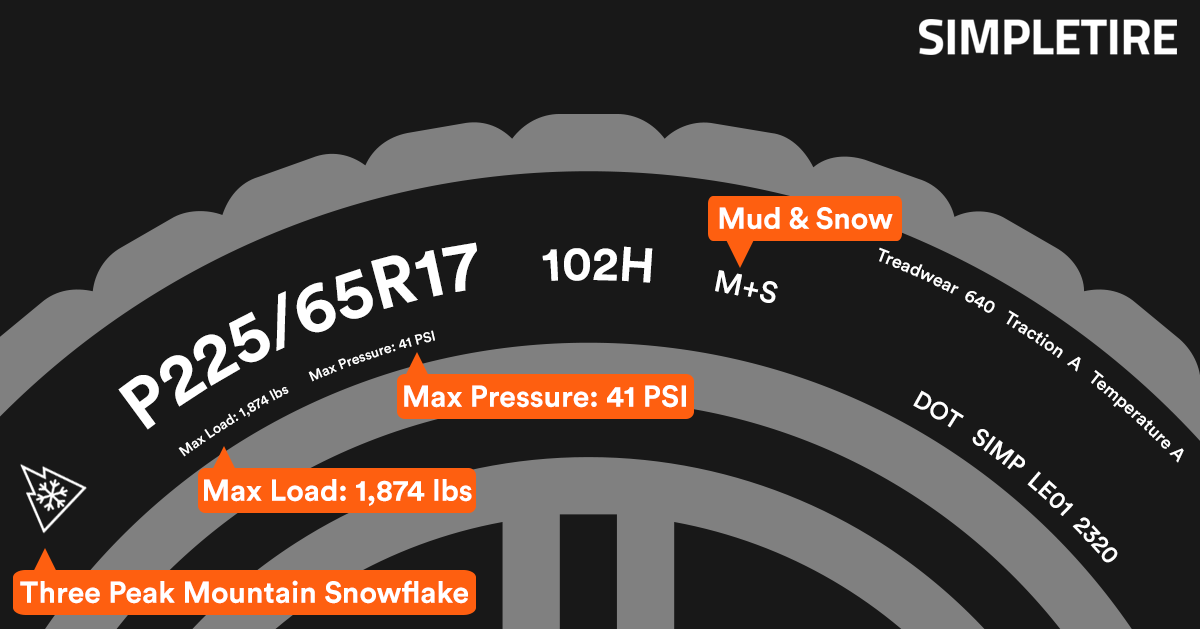Tire News & Information
Best price guarantee
Tire replacement coverage
24/7 roadside assistance
Easy returns

Tire codes may seem like a random jumble of letters and numbers, but they actually provide vital information about a tire's size, construction, and performance capabilities. Understanding how to read tire codes is essential for vehicle owners to ensure they select tires that match their specific make and model, as well as their driving needs.
The tire code explained here will help decipher the meaning behind each letter and number to simplify the tire buying process. Knowing what the numbers on tires represent empowers drivers to make informed decisions when it comes to tire selection and maintenance.
By familiarizing yourself with the key components of a tire code—including the section width, aspect ratio, construction type, wheel diameter, load index, and speed rating—you'll be well-equipped to choose tires that optimize your vehicle's performance and safety. Let's dive in and decode the secrets hidden within your tire's sidewall.
What do the numbers on tires mean?
Tire codes are more than just a random assortment of letters and numbers stamped on the sidewall—they provide critical insights into the tire's fundamental characteristics and capabilities. The tire size code is a universal language that communicates essential details about the tire's dimensions, such as its width, height, and diameter. These measurements dictate the tire's compatibility with specific vehicle makes and models, ensuring a proper fit for optimal performance and safety.
Beyond size, tire codes also convey information about the tire's internal construction, load-bearing capacity, and speed rating. The construction type, denoted by a letter like "R" for radial or "D" for diagonal, influences the tire's ride quality, handling, and durability. The load index and speed rating, represented by numbers and letters, respectively, indicate the maximum weight each tire can support and the top speed it can safely sustain over time.
Deciphering the meaning behind tire codes empowers vehicle owners to make well-informed decisions when selecting new tires or assessing the condition of their current set. By understanding the implications of each letter and number, drivers can ensure they choose tires that not only fit their vehicle but also align with their specific driving needs and conditions. Whether prioritizing comfort, performance, fuel efficiency, or all-terrain capabilities, knowing how to read tire codes is the key to unlocking the perfect tire combination for any vehicle and lifestyle.
Decoding the tire size code

Section width
The section width is the numerical value that begins the tire size code. It represents the measurement, in millimeters, of the tire's width from one edge to the other, ensuring it pairs correctly with the wheel rim. For example, a width marked as "215" indicates the tire spans 215 millimeters across when mounted on a wheel. This width is crucial for maintaining proper contact with the road surface, which influences stability and grip.
Aspect ratio
The aspect ratio follows the section width, providing insight into the tire's profile. Expressed as a percentage, it details the sidewall height relative to the tire's width. A tire with an aspect ratio of "65" means the sidewall height is 65% of the width, affecting how the vehicle handles and the smoothness of the ride. Lower ratios often enhance sporty handling, while higher ratios contribute to a smoother, more comfortable ride.
Construction type
Construction type, identified by a letter, describes the tire's internal build. "R" signifies radial construction, where the cords run at a 90-degree angle, enhancing flexibility and road contact. Other types include "D" for diagonal or bias and "B" for belted bias construction. Radial tires are favored for their superior durability and ride quality, making them the standard for most passenger vehicles.
Wheel diameter
Wheel diameter is indicated by the final digits, specifying the wheel size the tire fits, measured in inches. This measurement must match the wheel exactly: a tire coded with "16" fits a 16-inch wheel. Mismatching tire and wheel diameters can cause handling issues and uneven wear, emphasizing the importance of selecting the correct size for safe and efficient vehicle operation.
Load index and speed rating
Load index
The load index is a vital code found after the tire size, denoting the tire's ability to handle weight. This number ensures compatibility with the vehicle's weight specifications, helping to avoid overloading. For example, a tire with a load index of "94" can support a maximum of 1,477 pounds when properly inflated. Selecting the right load index is crucial for maintaining tire integrity and vehicle safety, as exceeding this limit can cause dangerous heat accumulation.
Speed rating
Speed ratings, indicated by a letter at the end of the tire size code, define the maximum speed a tire can maintain safely. This rating is critical for the tire's performance at various speeds, ensuring stability and control. Speed ratings range from L, suitable for speeds up to 75 mph, to Y, designed for speeds exceeding 186 mph. Most passenger tires fall between S (112 mph) and H (130 mph). It's essential to choose tires with a speed rating that corresponds with your vehicle's capabilities and driving conditions to prevent tire failure and ensure safe travel.
Additional sidewall information
The sidewall of a tire provides vital details beyond just size and performance specs. Among these is the DOT code, crucial for identifying the tire's manufacturing details. The last four digits specify the production week and year, helping you track the tire's age—a factor that influences safety and performance over time.
In addition to the DOT code, the sidewall displays ratings for treadwear, traction, and temperature. The treadwear rating, often a three-digit number, indicates the tire's expected lifespan compared to a control tire. Traction ratings, marked as AA, A, B, or C, reflect the tire's ability to stop on wet surfaces. Temperature ratings, ranging from A to C, show how well the tire withstands heat buildup during prolonged use.
The sidewall also states the maximum inflation pressure, which should not be confused with the recommended pressure for everyday driving. This figure indicates the upper limit of air pressure the tire can safely contain to support its maximum load capacity. Maintaining the correct inflation level is key to ensuring optimal performance, safety, and longevity of the tire.
Putting it all together
Tires serve as more than just the point where rubber meets the road—they are integral to your vehicle’s performance and safety ecosystem. Grasping the details laid out in tire codes allows drivers to choose tires that not only fit their vehicle specs but also complement their driving patterns. By becoming familiar with these codes, you can ensure that your tires are well-matched to the weight and speed requirements specified for your vehicle, enhancing both safety and efficiency.
Each component of the tire code offers insight into how the tire will perform in various driving scenarios. Understanding the specific capacity for weight and speed, as marked by the load index and speed rating, prevents issues such as overburdening the tire, which could lead to blowouts, and ensures that the tires can handle the pressures of everyday driving. The information displayed on the sidewall, including the manufacturing date and material specifications, provides a clearer picture of a tire's potential performance and durability over time.
Incorporating this knowledge into your tire maintenance and selection process can significantly extend the life of your tires and optimize vehicle handling. When you are well-informed, tire care becomes a strategic part of maintaining your car’s performance. For tailored advice, consulting with tire specialists can offer valuable insights, guiding you to the best tire choices for your specific vehicle and driving conditions.
At SimpleTire, we are committed to making your tire shopping experience as straightforward and hassle-free as possible. Our team of experts is always ready to help you find the perfect tires for your vehicle and driving needs. Shop for tires online at SimpleTire.com and discover how easy it is to get the best deals on top-quality tires from the comfort of your home.
Ready to find the perfect tires?
Search By